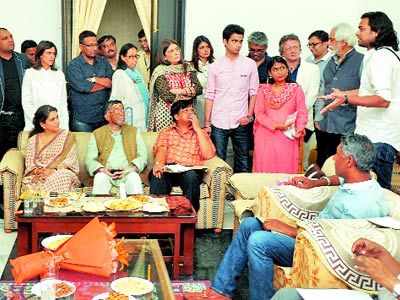Trending
This story is from May 22, 2015
Designers meet ministers for handloom revival
Design frat holds power meet with textiles minister for Banaras handloom revival project.

Design frat holds power meet with textiles minister for Banaras handloom revival project.
A veritable who’s who of the design fraternity in Delhi met textiles minister Santosh Gangwar in Delhi on Monday to push collectively for a fashion initiative. Led by designer-politician Shaina NC and FDCI president Sunil Sethi, they proposed a collective design effort to revive handlooms from Banaras, the PM’s constituency and a traditional hub of specialized textile crafts, as part of the Make in India campaign.Shaina described it as a “tribute to Indian textiles”, in which designers would make world-class products using the skills of Banarasi craftspersons and weavers, that would be put up in museums, showcased on international platforms, even perhaps debut in Davos.
Many of the designers present are already working in that space, and the group that met the minister on Monday wanted the ministry to announce the initiative under the Make in India campaign, improve the infrastructure for textile work in that city, and provide support to designers looking to work for the project.
There was talk of providing yarn at subsidized rates, setting up of dyeing centres, perhaps even buyer-seller meets to boost the commercial aspect. The designers present – Ritu Kumar, David-Abraham, Rahul Jain, Rohit Bal, Anju Modi, Rina Dhaka, Rajesh Pratap Singh, Shruti Sancheti, Abhishek Gupta, Reynu Taandon, Gaurav Gupta and representatives of Abu-Sandeep and Manish Malhotra – were accompanied by names like handicrafts expert Laila Tyebji, set designer Sumant Jayakrishnan and V Sunil from the Make in India marketing campaign.
Textiles secretary SK Panda, who accompanied the minister, detailed the measures that the government has already taken to strengthen weaver service centres and the distribution network. He said the government had started work on setting up of block-level offices in that area that would have internet and IT support to enable designers to communicate with weavers and craftspersons. He also promised support from the National Handloom Development Corporation in providing yarn or raw material.
One of the concerns that Shaina and the rest voiced was the need of a pointsperson in the ministry to coordinate this project. The minister, after hearing all the suggestions and concerns voiced, said he would appoint such a person, and also proposed that “agli baithak Varanasi mein ho”. “Aap sab ki ruchi aur samay ke liye main aabhari hoon,” he told the gathering as the meeting concluded. “Isse hum sahi dhang se aage badhana chahte hain.” The meeting ended with everyone agreeing on a tentative date in the first week of June to travel to Banaras with the ministry, and perhaps hold a large baithak involving local craftspersons and weavers, besides designers already working there.
“I am genuinely hopeful that the modalities will be worked out after the project is announced. No meeting with so many important stakeholders has ever happened in this manner – it was all worked out within two days – and I’m grateful to Shaina, who has taken the initiative,” said Sethi. “Many of our designers are already working in that space, and we are hopeful that the government will step in to help with the problems they are facing, creating a higher-end product with greater access to master weavers. It will give a fillip not only to Make in India and the government’s handlooms initiative, but also mean commercial success.” Panda added, “We are grateful for your (the designers’) support – we need the help and co-operation of the design community. We have no disagreement (with the vision and agenda of the proposal), and would like to work with designers to revive handlooms, largely Varanasi-specific handlooms. PM Narendra Modi has also said that handlooms need to be revived.”
A veritable who’s who of the design fraternity in Delhi met textiles minister Santosh Gangwar in Delhi on Monday to push collectively for a fashion initiative. Led by designer-politician Shaina NC and FDCI president Sunil Sethi, they proposed a collective design effort to revive handlooms from Banaras, the PM’s constituency and a traditional hub of specialized textile crafts, as part of the Make in India campaign.Shaina described it as a “tribute to Indian textiles”, in which designers would make world-class products using the skills of Banarasi craftspersons and weavers, that would be put up in museums, showcased on international platforms, even perhaps debut in Davos.
Many of the designers present are already working in that space, and the group that met the minister on Monday wanted the ministry to announce the initiative under the Make in India campaign, improve the infrastructure for textile work in that city, and provide support to designers looking to work for the project.
There was talk of providing yarn at subsidized rates, setting up of dyeing centres, perhaps even buyer-seller meets to boost the commercial aspect. The designers present – Ritu Kumar, David-Abraham, Rahul Jain, Rohit Bal, Anju Modi, Rina Dhaka, Rajesh Pratap Singh, Shruti Sancheti, Abhishek Gupta, Reynu Taandon, Gaurav Gupta and representatives of Abu-Sandeep and Manish Malhotra – were accompanied by names like handicrafts expert Laila Tyebji, set designer Sumant Jayakrishnan and V Sunil from the Make in India marketing campaign.
Among the many perspectives, Ritu spoke of the need to take Banarasi handlooms beyond Baba Kharak Singh Marg (the home of state handloom emporiums), and to pitch it as high art internationally, while Shaina said it should also go “beyond the wedding market”. Gudda emphasized that what they envisioned could be achieved if the government could provide support within a set timeline – and this pitch for quick action was echoed by the entire group. Abhishek Gupta, who’s already been working in that space, said that designers could ensure the quality of the products if they had marketing and infrastructure support. Rahul Mishra, who has worked extensively with chanderi, emphasized the need for “risk cover” for designers entering a new sector and working to make handlooms profitable.
Textiles secretary SK Panda, who accompanied the minister, detailed the measures that the government has already taken to strengthen weaver service centres and the distribution network. He said the government had started work on setting up of block-level offices in that area that would have internet and IT support to enable designers to communicate with weavers and craftspersons. He also promised support from the National Handloom Development Corporation in providing yarn or raw material.
One of the concerns that Shaina and the rest voiced was the need of a pointsperson in the ministry to coordinate this project. The minister, after hearing all the suggestions and concerns voiced, said he would appoint such a person, and also proposed that “agli baithak Varanasi mein ho”. “Aap sab ki ruchi aur samay ke liye main aabhari hoon,” he told the gathering as the meeting concluded. “Isse hum sahi dhang se aage badhana chahte hain.” The meeting ended with everyone agreeing on a tentative date in the first week of June to travel to Banaras with the ministry, and perhaps hold a large baithak involving local craftspersons and weavers, besides designers already working there.
“I am genuinely hopeful that the modalities will be worked out after the project is announced. No meeting with so many important stakeholders has ever happened in this manner – it was all worked out within two days – and I’m grateful to Shaina, who has taken the initiative,” said Sethi. “Many of our designers are already working in that space, and we are hopeful that the government will step in to help with the problems they are facing, creating a higher-end product with greater access to master weavers. It will give a fillip not only to Make in India and the government’s handlooms initiative, but also mean commercial success.” Panda added, “We are grateful for your (the designers’) support – we need the help and co-operation of the design community. We have no disagreement (with the vision and agenda of the proposal), and would like to work with designers to revive handlooms, largely Varanasi-specific handlooms. PM Narendra Modi has also said that handlooms need to be revived.”
End of Article
FOLLOW US ON SOCIAL MEDIA









